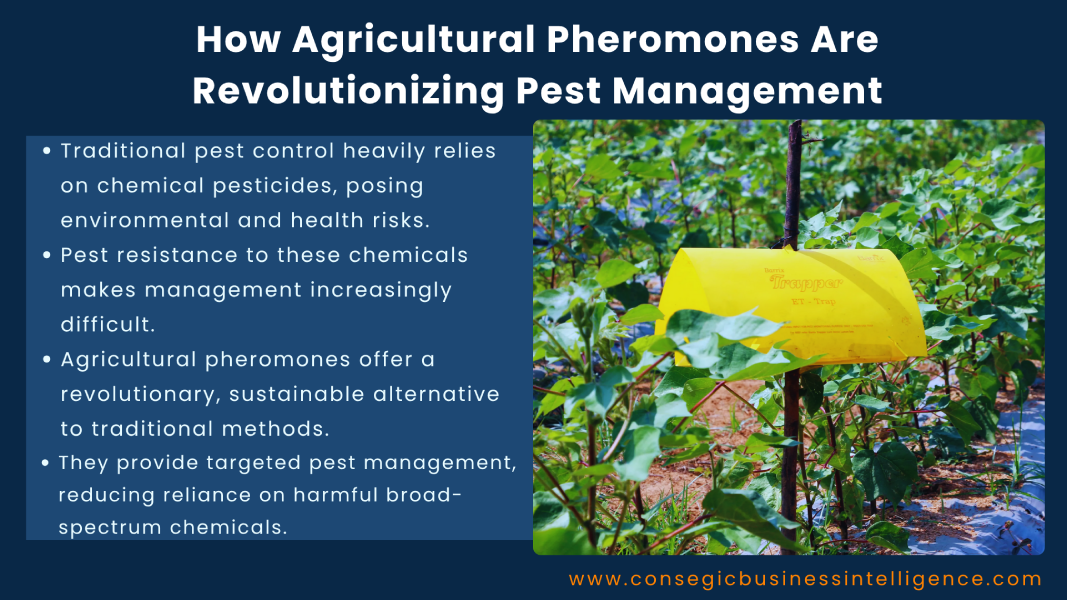How Agricultural Pheromones Are Revolutionizing Pest Management
Introduction:
Managing pests is a tedious and time-consuming task. It primarily relies on chemical pesticides, which cause a significant impact on the environment, human health, and the growing resistance in the pest populations has made it more difficult to manage.

Taking this into account, agricultural pheromones are emerging as a game changer, managing insects efficiently. These natural chemical signals are revolutionizing pest control practices, providing focused, environmentally friendly, and sustainable solutions that fuel the demands of modern age farming.
This blog sheds light on how agricultural pheromones are revolutionizing pest management, the science behind their function, and their real-world applications, benefits, and prospects.
What are agricultural pheromones?
Agricultural pheromones are chemicals secreted by insects and pests to establish communication with other insects of their species. These compounds help them act against biological mechanisms such as mating, aggregation, or dispersal. The scientific community is trying to develop tools that can manipulate these mechanisms in agricultural settings.
Several types of pheromones are employed in pest management, such as:
- Sex pheromones: to attract pests for mating, disrupting processes, and monitoring.
- Aggregation pheromones: to attract pests of a given niche for mass trapping.
- Alarm pheromones: to trigger dispersal or avoidance behavior.
- Trail pheromones: to guide pests, track their trail, and control their movement.
These naturally present pheromones can be mimicked to study the insect behavior, eventually killing them and reducing pest populations.
Transforming approaches in pest management
There is a major paradigm shift from traditional ways of pest control to a pheromone-based system. Common chemical pesticides usually kill all organisms, including the helpful insects. Pheromones, on the other hand, create a target-specific bubble, removing only the unwanted ones and eliminating unnecessary ecological consequences.
This precise control enables producers to adopt integrated pest management (IPM) techniques, combining pheromones with controlled environment agriculture, crop rotation, and minimal pesticide use. This provides a big picture that saves crops and preserves biodiversity.
Real-world applications in the field
Agricultural pheromones have a myriad of applications to control pests in the field, such as:
- Disrupting Mating
This approach includes confusing the male insects by releasing large amounts of sex pheromones, making it difficult for them to locate the female insects. This results in a major reduction in the reproductive rate of these insects and a gradual decline in the pest population.
- Mass Trapping
Aggregation pheromones are employed for this purpose by strategically placing field locations to lure insects and capture them in large numbers. This is mainly accountable in greenhouses and crops of high value, where pest infestation would cause major loss of produce.
- Supervision and threshold-based action
Pheromones are an ideal choice for the early detection of pest infestations. Trap monitoring aids farmers in detecting the presence of pests early and makes informed decisions for applying required actions and other control measures.
Advantages of agricultural pheromones over traditional pesticides
Pheromones provide a broad array of benefits over the common chemical pesticides, promoting green practices and environmental management. Since they are naturally occurring compounds, one of their major advantages is that they are safe for the environment. They are not toxic to nature, break down easily, and are required in small amounts.
Another major advantage is that they are specific to a species. Unlike pesticides, these compounds do not cause mass killing of pests and beneficial organisms indiscriminately. They only target specific pest species, reducing additional damage and disruptions to the food web.
Furthermore, they do not cause harmful long-term effects to humans as well as to the environment, are safer for farmers and consumers, and do not leach harmful residues into the soil. These determinants make these chemical compounds a perfect pest management system for organic farming.
What does the future hold for these pheromones?
The future of agricultural pheromones is bright, mainly driven by innovations and scientific advancements, escalating their effectiveness, accessibility, and affordability. Advances in technologies like sensor-based dispenser systems with built-in Internet of Things technology create a promising development.
These systems effectively monitor temperature, humidity, and manage pests in real-time. Additionally, with the introduction of nanotechnology and bioscience, creating more efficient delivery systems will simplify the process further.
To sum up, these innovations create a significant foundation for the future of agricultural pheromones, promoting sustainable farming accurately, securely, and enabling effective pest control
Conclusion:
Agricultural pheromones are changing the future of pest management by creating a sustainable, eco-friendly, and efficient alternative to commonly used chemical pesticides. This is made possible by these naturally occurring compounds called pheromones, the communication systems of insects.
With the paradigm shift towards modern agricultural practices, protecting nature and biodiversity, pheromones are becoming a significant tool. Also, increasing regulatory frameworks on pesticides and the rising demand for pheromones have transformed the landscape, focusing on more practical and natural solutions.
As innovation continues to drive their applicability and affordability, agricultural pheromones are significantly transforming the world into a smarter place, creating a more sustainable future in global food production.
